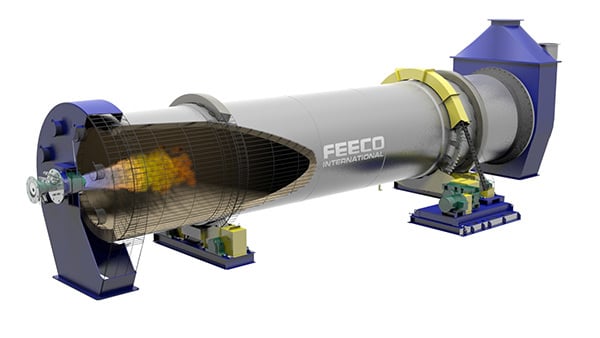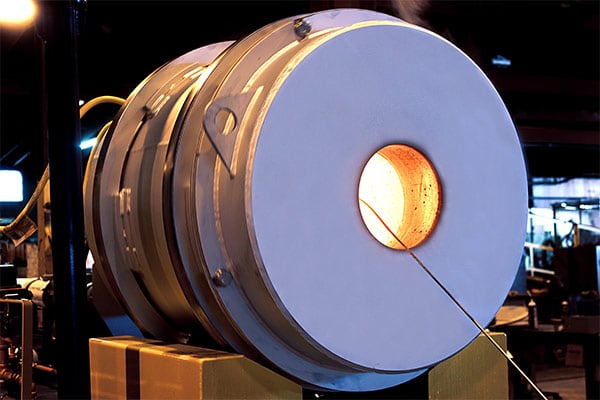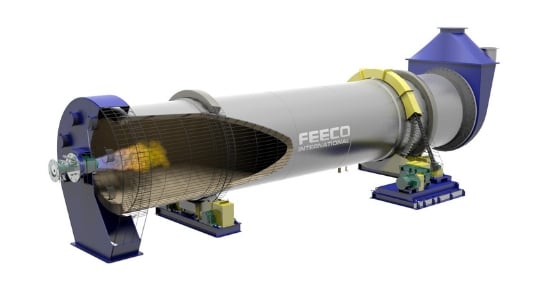Expanded clay aggregates, also called exclay, or lightweight expanded clay aggregates (LECA), are a beneficial material in a growing number of industries – most notably construction and horticulture, with water treatment and filtration applications likely next in line.
The unique structure and physical properties of expanded clay, which lend use to a variety of applications, are produced as a result of carefully controlled thermal treatment (typically referred to as either calcination or sintering) carried out in a rotary kiln.
Expanded Clay Aggregate Thermal Treatment (Calcination or Sintering)
The properties of expanded clay that make it ideal for use in a given application are achieved through a highly engineered production process.
Clays are typically crushed, agglomerated and/or dried as a means of feedstock preparation, though this process can vary. Extrusion seems to be the preferred method of agglomeration in this setting, but other methods may also be explored.
While feedstock preparation is essential in producing expanded clay aggregates, the key process behind expanded clay aggregates is a thermal treatment. This thermal treatment is where the expanded clay aggregate name is derived from, as it is used to physically expand the clay particles.
There are various terms to describe such thermal treatment techniques. In this setting, the treatment is typically referred to as either calcination or sintering. While the two terms are often used interchangeably, it’s important to note that they technically refer to different techniques. Since sintering technically happens at much higher temperatures, for the purposes of this article, we’ll refer to it as calcination, though in some cases expanded aggregates may be truly sintered.
In the case of expanded clay, calcination has an essential role in creating a product that can serve as an expanded clay aggregate. The temperature, typically between 1050 C and 1250 C, causes gases to be released as a result of various changes within the material, including the decomposition and reduction of ferric oxides, the combustion of organics, the blowing of entrapped water, and the decomposition of carbonates.³
This release of gases causes a physical expansion, or bloating of the clay, leaving it with a lower density, higher porosity, and a much greater surface area within the material, along with a hardened surface – all characteristics that make it ideal for use as a lightweight aggregate.
Factors Influencing Clay Expansion During Calcination
As with most materials, various factors must be optimized in the production process in order to achieve the best results. An extensive study conducted on three different clay sources found that while a number of factors are important, the process parameters of the expansion process that are perhaps most critical include:4
Processing Temperature
Processing temperature is the most influential factor in the expansion process. Expansion was found to increase along with temperature, to just below the specific clay’s melting point (the melting point varies depending on the type of clay).
Grain Size of Clay
The study found that the grain size of clay was also an impacting factor, with expansion increasing as grain size is reduced.
Pellet Size
Pellet or agglomerate size was also found to have an effect on expansion, with expansion increasing in tandem with pellet size. Consequently, a decrease in pellet size correlates with less expansion.
Retention Time
The optimal retention time was found to be specific to the type of clay being processed. Optimal retention time was important, as consequences of both inadequate and excessive times were observed.
The Rotary Kiln
The preferred equipment for carrying out the clay expansion process is the rotary kiln.
Rotary kilns are available in either a direct- or indirect-fired configuration and are often referred to as a calciner. The production of expanded clay aggregates is typically carried out in a direct-fired kiln, in which the clay and products of combustion are in direct contact with each other.
Direct-fired kilns can be configured for co-current or counter-current airflow, but counter-current is generally a more efficient process setup in this setting.

3D Model of a direct-fired rotary kiln
Why Clay as a Lightweight Aggregate
Like many lightweight aggregates (LWA), the use of expanded clays can provide a wide range of both economic and environmental benefits:
Economic Benefits
The use of lightweight aggregates offers many economic incentives, including:
- Reduced structural costs in construction applications
- Reduced transportation costs
- Lower costs and reduced reliance on imports where applicable
Environmental Benefits
According to the European Expanded Clay Association (EXCA), expanded clay is a sustainable material with a number of environmental benefits:
- Reduced CO2 emissions when used as a replacement for fossil fuels
- Reduced CO2 emissions in construction and transport industries
- Improved energy efficiency in buildings
- 100% recyclability
- Chemically inert (no harmful components and subsequently, no potential for the release of VOCs or leaching contaminants
- Water and air filtration benefits
- High product to feedstock ratio (one cubic meter of clay can yield five cubic meters of expanded clay)
Additionally, opportunity lies in utilizing recovered or recycled clay materials, further pushing the sustainability of this material.
Uses of LECA
While the applications in which lightweight expanded clay aggregate (LECA) can be used continue to grow, there are currently two primary avenues for LECA products:
Construction
Construction is the most common application for LECA. Expanded clay can be found in all manner of concrete, filler, and structural components of the construction and building materials industry. Benefits it can offer in this setting include:²
- High durability with low maintenance and a long life
- Strength and stability
- Completely non-combustible (fire resistant)
- 100% recyclability mitigates disposal issues
- Lightweight without sacrificing strength
- Serves as a thermal insulator
- Provides noise reduction
- Promotes water drainage
- Non-toxic
Horticulture
The use of LECA in horticulture is a comparatively new application but remains a growing field. Expanded clay aggregates can promote a variety of benefits under various growing conditions. This includes:¹
- Improved aeration (especially when used as a substrate in commercial container-growing operations) and reduced compaction
- Potential for increased water and nutrient holding
- Enhanced cation exchange capacity
- Resistant to breakdown over time
- Possible use as a weed barrier
In addition to construction and horticulture, LECA is also being examined for use in water treatment and filtration applications.
Testing: Essential to Success with Expanded Clay
As with many thermal processing endeavors, testing is a critical element of a successful clay expansion operation. Research has shown that the ideal process parameters are unique to the type of clay being processed.
Testing clay samples at batch-scale to gather initial process data is the first step in a successful testing program. Data gathered during batch testing can then be used to scale up testing to continuous, pilot-scale runs. Testing can also be used to aid in finding a balance between ideal process parameters and what is economically feasible.
The FEECO Innovation Center offers a variety of test kilns for conducting both batch and pilot testing. Kilns can be configured with various support equipment to simulate different conditions of commercial operation.
The testing of various methods of agglomeration may also be combined to develop ideal pellet characteristics for the unique clay source being considered.

Batch kiln used for testing in the FEECO Innovation Center
The Innovation Center’s automation control system collects a broad range of data, which can be trended and analyzed in real time for unmatched process transparency. This includes data points such as feed and product rates, relevant temperature readings, system pressures, gas sampling and analysis, and more.
Conclusion
Expanded clay aggregates are a beneficial material in the construction industry, with applications in horticulture and water treatment growing. Rotary kilns are the device of choice for processing clay agglomerates into expanded clay aggregates.
The ability to optimize process parameters to produce a superior expanded clay product is critical to the success of an operation. FEECO offers extensive testing capabilities for those in the process and product development stages. We then use the data gathered during testing to engineer and manufacture custom, commercial-scale rotary kilns of the highest quality. For more information on our capabilities around expanded clay aggregates, contact us today!



